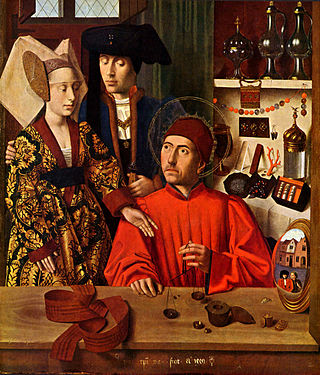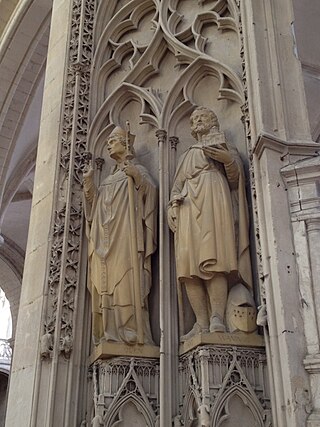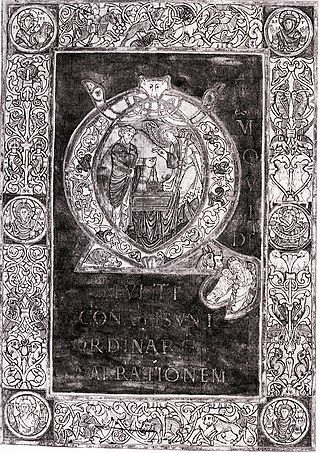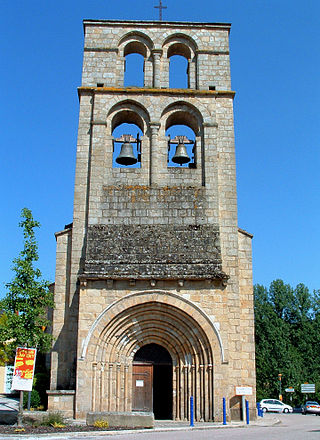Veneration
Soon after his death in November 640, he was venerated as a Saint. He was succeeded as bishop by Eligius. [3]
His memorial is 27 Nov. [4] Acarius is invoked against a "cantankerous" mood. [5] The Église Saints-Hugues-et-Achaire de Haspres
Acarius (died 14 March 642), venerated as Saint Acarius, was a monk of Luxeuil Abbey who became Bishop of Doornik and Noyon, which today are located on either side of the Franco-Belgian border.
Acarius was born to a noble family of Burgundy. He entered the Abbey of Luxeuil and was a pupil of Abbot Eustace. Audomar, future bishop of Thérouanne was a classmate.
While the date of his election is not known, it is assured that he was bishop of Doornik and Noyon in 627. He was an adviser to King Clothar II. Apparently, Acarius had great influence on the spreading of Christianity in Belgic Gaul. It was Acarius that recommended to Dagobert that Audomar be appointed Bishop of Thérouanne. [1] He was a strong supporter of the missionary Amandus, but despite his influence could not prevent King Dagobert I from banishing Amandus for chastising him. [2] Amandus then went to Gascony. Along with Audomar and the King's counselor, Éloi, they were eventually able to persuade Dagobert to allow Amandus to return, and Acarius sent him to preach in the area of Tournai.
As bishop, Acarius was especially attentive to the poor and afflicted, whose needs he enjoyed relieving and calming their suffering. He built a number of monasteries.
Soon after his death in November 640, he was venerated as a Saint. He was succeeded as bishop by Eligius. [3]
His memorial is 27 Nov. [4] Acarius is invoked against a "cantankerous" mood. [5] The Église Saints-Hugues-et-Achaire de Haspres

Year 639 (DCXXXIX) was a common year starting on Friday of the Julian calendar. The denomination 639 for this year has been used since the early medieval period, when the Anno Domini calendar era became the prevalent method in Europe for naming years.

Noyon is a commune in the Oise department, northern France.

Eligius, venerated as Saint Eligius, was a Frankish goldsmith, courtier and bishop who was chief counsellor to Dagobert I and later Bishop of Noyon–Tournai. His deeds were recorded in Vita Sancti Eligii, written by his friend Ouen of Rouen.

Amandus, commonly called Saint Amand, was a bishop of Tongeren-Maastricht and one of the great Christian missionaries of Flanders. He is venerated as a saint, particularly in France and Belgium.

Audoin, venerated as Saint Audoin, was a Frankish bishop, courtier, hagiographer and saint. He authored Vita Sancti Eligii which outlines the life and deeds of Eligius, his close friend and companion in the royal court and the Church.

Bertin, also known as SaintBertin the Great, was the Frankish abbot of a monastery in Saint-Omer later named the Abbey of Saint Bertin after him. He is venerated as a saint by the Catholic and Orthodox Churches. The fame of Bertin's learning and sanctity was so great that in a short time more than 150 monks lived under his rule. Among them were St. Winnoc and his three companions who had come from Brittany to join Bertin's community and assist in the conversions. Nearly the whole Morini region was Christianized.

Medardus or Medard was the Bishop of Noyon. He moved the seat of the diocese from Vermand to Noviomagus Veromanduorum in northern France. Medardus was one of the most honored bishops of his time, often depicted laughing, with his mouth wide open, and therefore he was invoked against toothache.

Felix of Burgundy, also known as Felix of Dunwich, was a saint and the first bishop of the kingdom of the East Angles. He is widely credited as the man who introduced Christianity to the kingdom. Almost all that is known about him comes from The Ecclesiastical History of the English People, completed by the English historian Bede in about 731, and the Anglo-Saxon Chronicle. Bede wrote that Felix freed "the whole of this kingdom from long-standing evil and unhappiness".

Saint Audomar, better known as Saint Omer, was a bishop of Thérouanne, after whom nearby Saint-Omer in northern France was named.
Saint Remaclus was a Benedictine missionary bishop.
The former French diocese of Thérouanne controlled a large part of the left bank of the river Scheldt during the Middle Ages. Territorially it was part of the county of Artois which belonged to the county of Flanders.
Eustace of Luxeuil, also known as Eustasius, was the second abbot of Luxeuil from 611. He succeeded his teacher Columbanus, to whom he had been a favorite disciple and monk. He had been the head of the monastic school.

The Diocese of Tournai is a Latin Church ecclesiastical territory or diocese of the Catholic Church in Belgium. The diocese was formed in 1146, upon the dissolution of the Diocese of Noyon and Tournai, which had existed since the seventh Century. It is now suffragan in the ecclesiastical province of the metropolitan Archdiocese of Mechelen–Brussels. The cathedra is found within the Cathedral of Notre-Dame de Tournai, which has been classified both as a major site for Wallonia's heritage since 1936 and as a World Heritage Site since 2000.
Waldalenus, or Wandalenus, dux in the region between the Alps and the Jura, in the Frankish Kingdom of Burgundy, was a Frankish magnate who served as mayor of the Austrasian palace at Metz from 581, during the minority of Childebert II.

Maurontius of Douai was a nobleman and Benedictine abbot. His parents were Rictrude and Adalbard. He is a Catholic saint, with a feast day on May 5, especially venerated in Douai, France. His sisters Clotsinda, Adalsinda and Eusebia of Douai are also saints.

November 26 - Eastern Orthodox liturgical calendar - November 28

The County of Flanders was one of the most powerful political entities in the medieval Low Countries, located on the North Sea coast of what is now Belgium. Unlike its neighbours such as the counties of Brabant and Hainaut, it was within the territory of the Kingdom of France. The counts of Flanders held the most northerly part of the kingdom, and were among the original twelve peers of France. For centuries, the economic activity of the Flemish cities such as Ghent, Bruges and Ypres made Flanders one of the most affluent regions in Europe, and also gave them strong international connections to trading partners.
Saint Mommolin of Noyon was a monk who became an abbot in Saint-Omer, then Bishop of Noyon-Tournai in Belgium. His feast day is 16 October.

Saint Thillo was a Saxon slave who was converted by Saint Eligius and became a priest at Solignac Abbey. He accompanied Eloi in missionary work, returned to Solignac, and was made abbot. Unable to handle the responsibility, he left the abbey and became a hermit. His feast day is 7 January.

Solignac Abbey, or the Abbey of Saint-Peter and Saint Paul of Solignac, is an abbey in Solignac, near Limoges, in Haute-Vienne. It was founded around 631 AD by Saint Eligius (Éloi). The present buildings date to the 12th century, but have been modified many times since then. The abbey was dissolved during the French Revolution and the buildings were put to new uses, including a prison, boarding school, porcelain factory and seminary. As of 2021 there were plans to restore it back to its original function as a monastery.